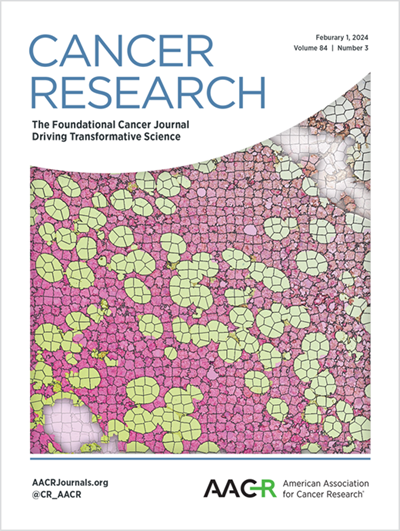CXCL10 Secreted by Pericytes Mediates TNFα-Induced Vascular Leakage in Tumors and Enhances Extravasation of Nanoparticle-Based Chemotherapeutics.
IF 12.5
1区 医学
Q1 ONCOLOGY
引用次数: 0
Abstract
Tumor necrosis factor-alpha (TNFα) induces vascular permeability and plays an important role in inflammation. In addition, TNFα-induced vascular leakage is involved in the increased extravasation of nanoparticle-formulated chemotherapeutic drugs, improving drug delivery and subsequent tumor response. Here, we uncovered a positive correlation between the presence of pericytes in the tumor-associated vasculature and TNFα-induced leakage and drug delivery, especially when drugs were encapsulated in nanoparticles. RNA-sequencing and pathway analysis identified high expression of CXCL10 in TNFα-stimulated pericytes. In addition, TNFα increased CXCL10 protein production by pericytes in vitro. In animal studies, tumor types with vessels with high pericyte coverage showed enhanced permeability and extravasation of drugs encapsulated in nanoparticles following treatment with TNFα, which could be blocked with a CXCL10 neutralizing antibody. In contrast, tumors harboring vessels with low pericyte numbers did not display increased drug extravasation in response to TNFα. Lack of pericyte coverage could be compensated by co-administration of CXCL10. These findings reveal a mechanism by which TNFα induces CXCL10 release from pericytes, resulting in increased endothelial permeability, vascular leakage, and drug delivery.求助全文
约1分钟内获得全文
求助全文
来源期刊

Cancer research
医学-肿瘤学
CiteScore
16.10
自引率
0.90%
发文量
7677
审稿时长
2.5 months
期刊介绍:
Cancer Research, published by the American Association for Cancer Research (AACR), is a journal that focuses on impactful original studies, reviews, and opinion pieces relevant to the broad cancer research community. Manuscripts that present conceptual or technological advances leading to insights into cancer biology are particularly sought after. The journal also places emphasis on convergence science, which involves bridging multiple distinct areas of cancer research.
With primary subsections including Cancer Biology, Cancer Immunology, Cancer Metabolism and Molecular Mechanisms, Translational Cancer Biology, Cancer Landscapes, and Convergence Science, Cancer Research has a comprehensive scope. It is published twice a month and has one volume per year, with a print ISSN of 0008-5472 and an online ISSN of 1538-7445.
Cancer Research is abstracted and/or indexed in various databases and platforms, including BIOSIS Previews (R) Database, MEDLINE, Current Contents/Life Sciences, Current Contents/Clinical Medicine, Science Citation Index, Scopus, and Web of Science.
 求助内容:
求助内容: 应助结果提醒方式:
应助结果提醒方式:


